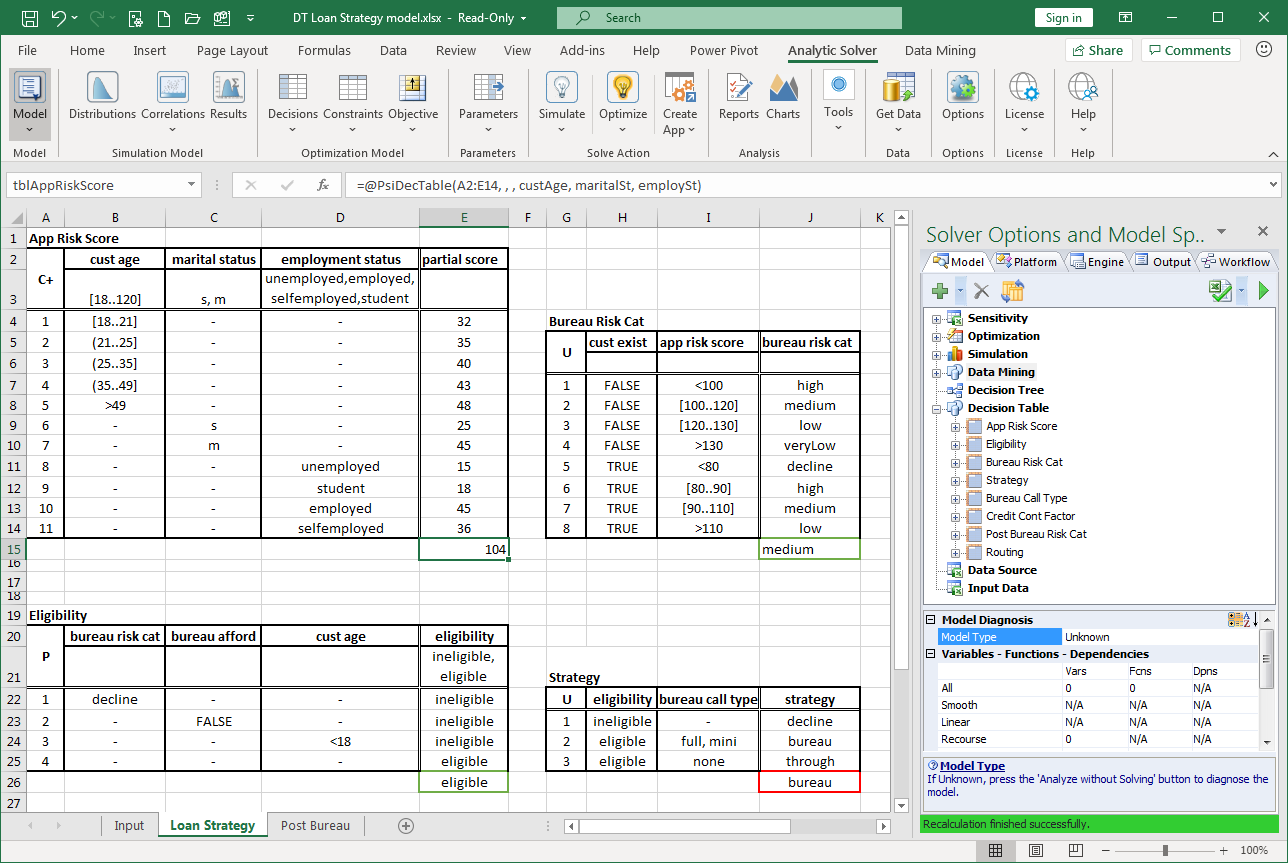We've just released Analytic Solver V2020, the latest version of our best-selling analytic software suite for Microsoft Excel. This means that both Analytic Solver Desktop and Analytic Solver Cloud now have all the enhancements described in this post. We give you both of these versions for one price -- the same price we used to charge for just Analytic Solver Desktop.
If you aren't aware of this already, please read our May 2019 post: Analytic Solver Desktop is the version you get by downloading and running our SolverSetup program, working in Excel for Windows (only). Analytic Solver Cloud is the version you get from Microsoft AppSource, or just by using the Insert Office Add-in menu in Excel -- it works in a browser with Excel for the Web, and in Excel for Windows and Excel for Macintosh.
As the new decade begins, we're confident that Analytic Solver gives you far more than any alternative for Excel. It is far better aligned with the future of Office 365 and Excel, and delivers far more analytic power than other vendors offer, at anywhere near our prices. And we're just getting started for 2020!
- Faster Solver Engines, Using Multiple Cores
- Monte Carlo Simulation Enhancements
- Business Rules in DMN-Compatible Decision Tables
Faster Solver Engines, Using Multiple Cores
In V2020, the LP/Quadratic Solver – probably the most-used Solver Engine in Analytic Solver – features significantly improved performance on linear mixed-integer models. Prior versions of this Solver would use only one processor core at a time, but V2020 will use multiple processor cores to speed your solution.
The plug-in large-scale Solver Engines in Analytic Solver V2020 also feature significantly improved performance (they continue to utilize multiple processor cores). These include the Gurobi Solver V9.0, with a new ability to solve non-convex quadratic models; the Xpress Solver V35, with a new Solution Refiner, and the Artelys Knitro Solver V12.1, with SOCP and MIP speedups.
Monte Carlo Simulation Enhancements
Analytic Solver V2020 includes 12 new probability distribution functions, enhanced property functions for the PSI Distribution functions, new property functions for the PSI Statistics functions, and new “theoretical” functions that return analytic moments of distributions. Full details are in the V2020 Frontline Solvers Reference Guide, but here’s a partial list of new/enhanced functions:
|
PsiBurr |
PsiLevyAlt |
PsiTheoMin |
|
PsiDagum |
PsiHypSecantAlt |
PsiTheoMax |
|
PsiDblTriange |
PsiCumulD |
PsiTheoVariance |
|
PsiFatigue |
PsiLaplace |
PsiTheoStdDev |
|
PsiFdist |
PsiCauchy |
PsiTheoSkewness |
|
PsiFrechet |
PsiTruncate |
PsiTheoKurtosis |
|
PsiHypSecant |
PsiCensor |
PsiTheoRange |
|
PsiJohnsonSBn |
PsiLock |
PsiTheoPercentile |
|
PsiJohnsonUB |
PsiOutput |
PsiTheoPercentileD |
|
PsiKumaraswamy |
PsiTheoMean |
PsiTheoTarget |
|
PsiReciprocal |
PsiTheoMedian |
PsiTheoTargetD |
|
PsiLevy |
PsiTheoMode |
PsiCategory |
These functions make it even easier to adapt risk analysis models developed with other popular Excel add-ins to work with Analytic Solver. A simple Find and Replace of the function name prefix with ‘Psi’ is often all you need. And unlike those other Excel add-ins, with Analytic Solver you can easily run your model in the cloud with Excel for the Web, translate your model to RASON, and use it in Power BI, Tableau, or your own web or mobile application!
Business Rules in DMN-Compatible Decision Tables
We recently introduced another completely new capability to Analytic Solver: Making it easy to capture rule-based decisions in the form of decision tables, with multiple columns for inputs, and multiple rows that express business rules. Why? Because analytics that don't lead to decisions and actions aren't good for much. Many pundits and vendors are talking about AI and predictions from machine learning: You can easily build those ML predictive models using the full power of Analytic Solver's Data Mining tab -- but business rules in decision tables give you an organized way to turn those predictions into actions.
While Business Rule Management Systems (BRMS) have been around for 15 years, they've begun to give way to Decision Management Systems that support a mix of rules and analytics. Where older BRMS systems used proprietary rules languages, the new trend embraces an open standard called DMN (Decision Model and Notation), with a language called FEEL (Friendly Enough Expression Language) for business rules. Analytic Solver V2020 make it easy for you to create and test DMN 1.2-compatible decision tables with business rules expressed in FEEL. For more information, just login and download the V2020 Frontline Solvers User Guide.

